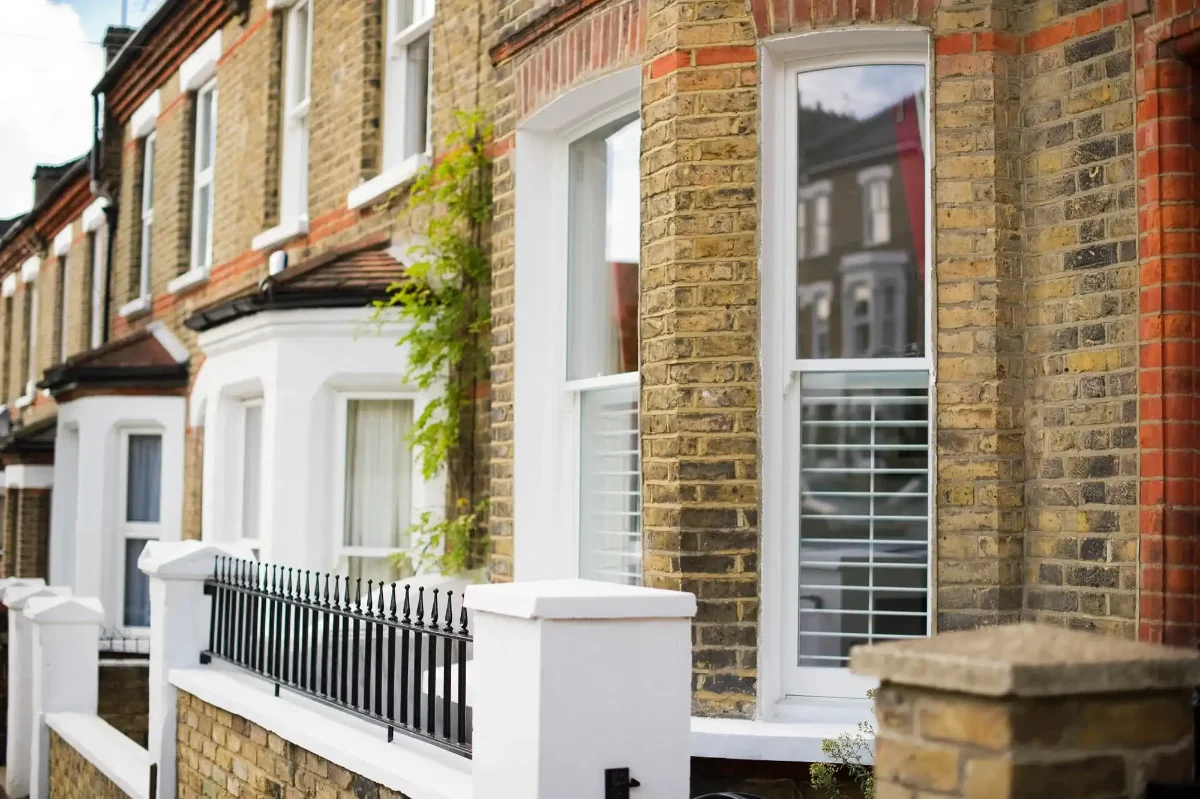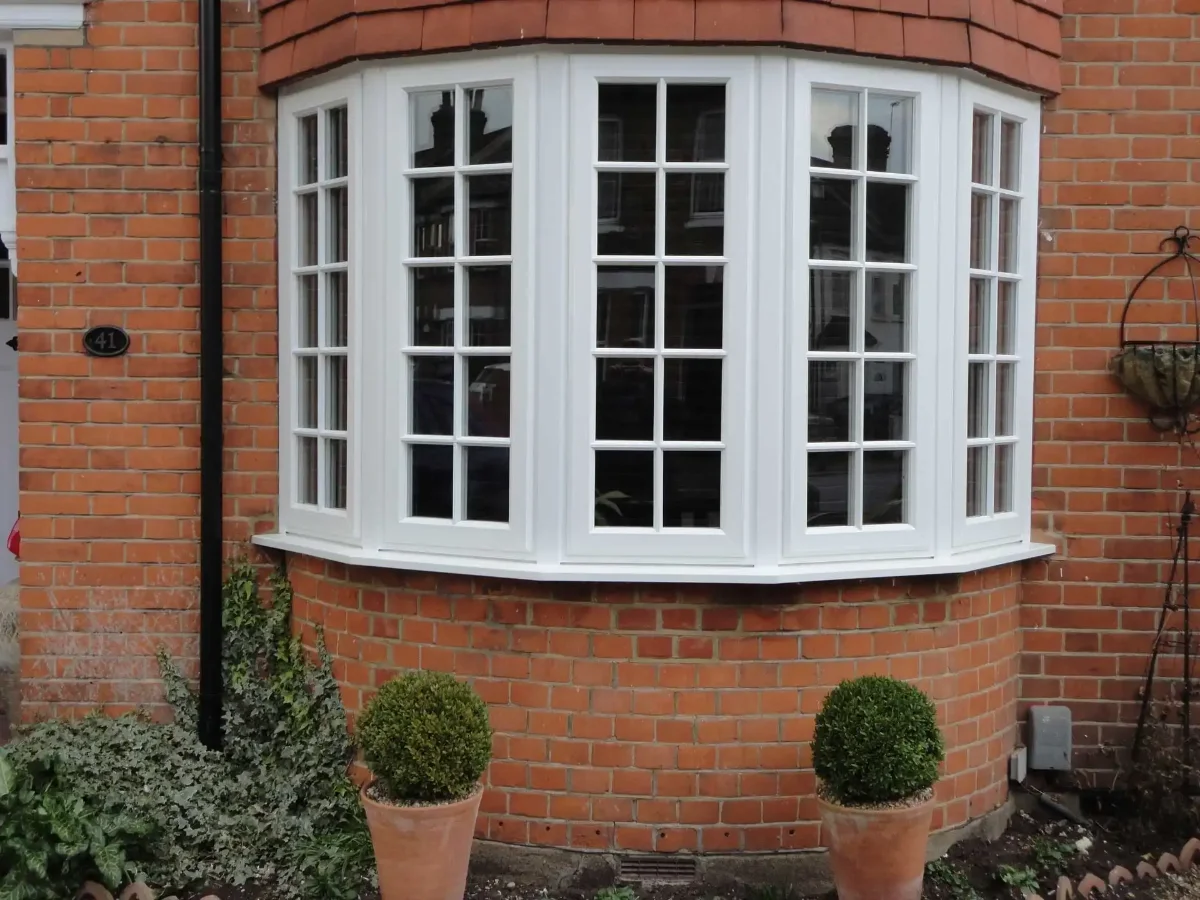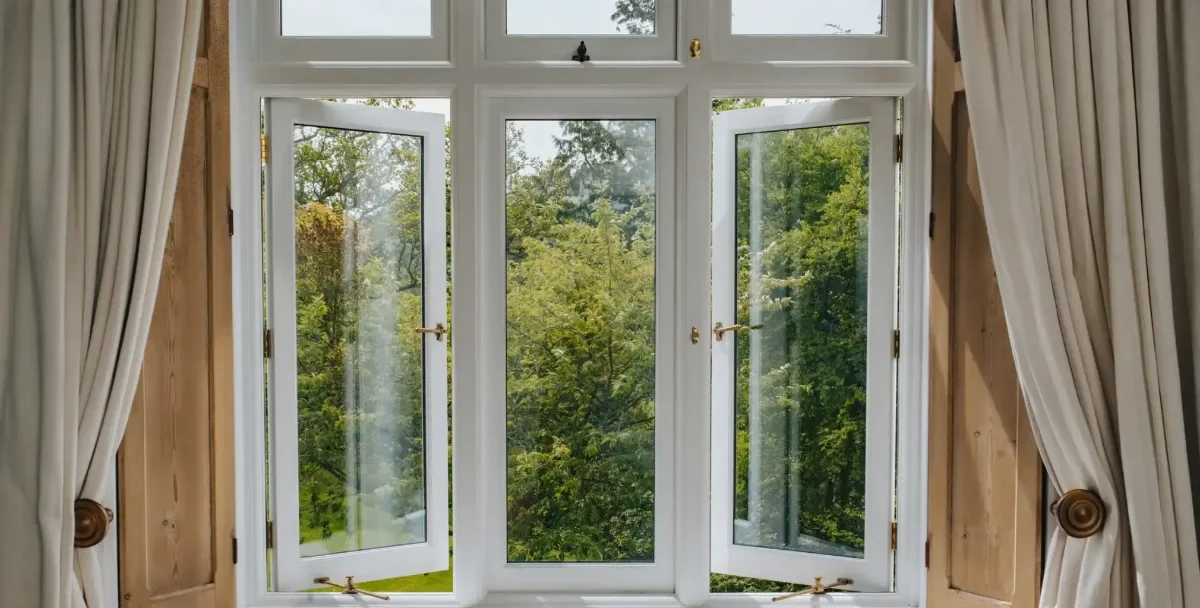The £15,000 Question: Replace or Restore?
“Our Victorian sash windows are beautiful, but they’re costing us a fortune in heating bills,” said Marcus Webb, standing in his Grade II listed home in Much Hadham. “The conservation officer says replacement isn’t an option, but three different contractors have given us wildly different quotes for refurbishment. How do we know what’s actually worth doing?”
This dilemma plays out in thousands of UK homes every year. Original windows with character and charm, but performance that belongs in the 19th century. The choice between replacement and refurbishment isn’t just about money—it’s about balancing heritage, performance, planning requirements, and long-term value.
After working through Marcus’s project—and hundreds of similar decisions over nearly four decades—I’ve learned that the “obvious” choice is rarely obvious. Sometimes a £3,000 refurbishment outperforms a £8,000 replacement. Sometimes it doesn’t.
The key is understanding what you’re really comparing, what each approach can and cannot achieve, and how to make the decision that’s right for your specific situation.
Let me share the framework I use to help homeowners navigate this complex choice.
Understanding Your Starting Point: Window Assessment
Before any cost comparison makes sense, you need to understand what you’re working with. Not all “old windows” are created equal.
The Five-Point Window Health Check
1. Structural Integrity
- Frame condition: Sound timber vs. rot, decay, or structural damage
- Joint stability: Tight mortise and tenon vs. loose, failing connections
- Sill condition: Intact weathering vs. water damage and decay
- Hardware function: Working vs. seized, missing, or damaged mechanisms
2. Glazing Assessment
- Glass condition: Original crown glass vs. cracked, missing, or poor replacements
- Putty condition: Sound glazing compound vs. failing, missing, or painted over
- Seal integrity: Weather-tight vs. significant air infiltration
- Safety compliance: Adequate vs. requiring safety glass upgrades
3. Performance Evaluation
- Thermal efficiency: Current U-values and air leakage rates
- Weather resistance: Water penetration and wind resistance
- Security adequacy: Locks, latches, and overall security provision
- Operational function: Smooth operation vs. sticking, binding, or failure
4. Heritage Significance
- Historical authenticity: Original features vs. later alterations
- Architectural importance: Contributing to building character vs. replaceable elements
- Planning constraints: Listed building or conservation area requirements
- Material rarity: Unique glazing, hardware, or construction techniques
5. Maintenance History
- Previous work: Quality of past repairs and maintenance
- Paint condition: Protective coatings vs. bare, weathered timber
- Hardware maintenance: Lubricated, adjusted vs. neglected mechanisms
- Ongoing care: Evidence of regular vs. deferred maintenance
Marcus’s Case Study: Victorian Sash Window Dilemma
Marcus’s Much Hadham property presented classic challenges that illustrate the decision-making process:
The Property Context
- Building: 1880s Victorian villa, Grade II listed
- Windows: 18 original box sash windows, various conditions
- Problems: High heating bills, draughts, operational difficulties
- Constraints: Conservation area restrictions, limited budget
- Goals: Improved comfort, reduced energy costs, maintained character
Initial Assessment Results
Structural condition:
- 12 windows: Generally sound timber, minor repairs needed
- 4 windows: Moderate rot in sills, some frame deterioration
- 2 windows: Severe deterioration, structural integrity compromised
Performance issues:
- Air leakage: 15-20 air changes per hour (should be <5)
- U-values: 4.8 W/m²K (Building Regs require <1.6)
- Security: Original brass hardware, minimal security provision
- Operation: 8 windows stuck or very difficult to operate
Heritage value:
- Original crown glass in 14 windows
- Intact box frames with original pulleys and weights
- Period brass hardware throughout
- Significant contribution to building’s listed status
The Three Options Explored
Option 1: Full Replacement
- Cost estimate: £28,000-£35,000
- Planning: Likely refusal without exceptional justification
- Performance: Modern standards achievable
- Character: Significant loss of authenticity
Option 2: Comprehensive Refurbishment
- Cost estimate: £18,000-£24,000
- Planning: Fully compliant with conservation requirements
- Performance: Significant improvement, though not matching new
- Character: Full retention of original features
Option 3: Selective Approach
- Replace 2 severely deteriorated windows: £3,200
- Refurbish 16 repairable windows: £14,400
- Total cost: £17,600
- Planning: Compromise approach, likely acceptable
- Performance: Mixed but practical solution
Cost Breakdown: What You Actually Pay For
Understanding cost structures helps evaluate quotes and make informed decisions:
Window Replacement Costs (Per Window)
Basic uPVC replacement:
- Supply: £200-£400
- Installation: £150-£250
- Total: £350-£650 per window
Timber replacement (heritage style):
- Supply: £800-£1,500
- Installation: £200-£400
- Total: £1,000-£1,900 per window
High-performance timber:
- Supply: £1,200-£2,500
- Installation: £250-£450
- Total: £1,450-£2,950 per window
Additional costs:
- Planning applications: £200-£500
- Building control: £150-£400
- Structural modifications: £500-£2,000
- Making good (decoration): £200-£800 per window
Window Refurbishment Costs (Per Window)
Basic restoration:
- Draught-proofing: £80-£150
- Hardware overhaul: £50-£120
- Glazing repairs: £60-£200
- Decoration: £100-£250
- Total: £290-£720 per window
Comprehensive refurbishment:
- Timber repairs: £150-£400
- Complete reglaze: £200-£400
- Hardware replacement: £100-£300
- Professional decoration: £200-£400
- Secondary glazing: £300-£600
- Total: £950-£2,100 per window
Extensive restoration:
- Structural repairs: £300-£800
- Specialist glazing: £400-£800
- Period hardware: £200-£500
- Conservation-grade decoration: £300-£600
- Total: £1,200-£2,700 per window
Performance Comparison: What Each Approach Delivers
Thermal Performance
New Windows:
- U-values: 1.0-1.6 W/m²K (meets current Building Regulations)
- Air leakage: <3 air changes per hour
- Immediate performance: Full specification from installation
- Longevity: 20-30 years before major maintenance needed
Refurbished Windows:
- U-values: 2.5-4.0 W/m²K (improvement but not current standards)
- Air leakage: 5-10 air changes per hour (significant improvement)
- Performance development: Improves with comprehensive secondary glazing
- Longevity: 30-50 years with proper maintenance
Performance enhancement options for refurbishment:
- Secondary glazing: Can achieve 1.8-2.5 W/m²K
- Draught-proofing: Reduces air leakage by 60-80%
- Thermal curtains: Additional insulation during heating season
- Smart controls: Optimized operation for efficiency
Security and Functionality
New Windows:
- Modern multi-point locking systems
- Toughened or laminated safety glass
- Smooth operation with modern hardware
- Compliance with current security standards
Refurbished Windows:
- Upgraded locks and security hardware possible
- Safety glass installation where required
- Restored smooth operation
- Character hardware maintained with security additions
Maintenance Requirements
New Windows:
- Minimal maintenance for first 10-15 years
- Standard cleaning and occasional lubrication
- Warranty coverage for defects
- Predictable replacement cycle
Refurbished Windows:
- Regular maintenance essential (every 3-5 years)
- Ongoing timber care and decoration
- Hardware adjustment and lubrication
- Responsive maintenance for optimal performance
The Decision Framework: Choosing Your Path
When Replacement Makes Sense
Structural failure:
- Extensive rot beyond economic repair
- Frame distortion affecting operation
- Repeated failure of previous repairs
- Safety concerns with existing structure
Performance priorities:
- Maximum energy efficiency required
- Minimal ongoing maintenance desired
- Modern security standards essential
- No planning constraints preventing replacement
Economic factors:
- Refurbishment costs approaching replacement costs
- Long-term ownership with payback time available
- Budget allows for quality replacement
- Property improvement investment strategy
When Refurbishment Is Preferred
Heritage considerations:
- Listed building or conservation area constraints
- Original windows contribute significantly to character
- Rare or historically important glazing/hardware
- Community or planning pressure to retain
Economic advantages:
- Significantly lower cost than quality replacement
- Phased approach spreads costs over time
- Existing windows structurally sound
- Short to medium-term ownership plans
Performance adequacy:
- Current performance acceptable with improvements
- Secondary glazing achieves required efficiency
- Character preservation outweighs performance gains
- Environmental preference for material retention
Marcus’s Solution: The Selective Strategy
After detailed analysis, Marcus chose the selective approach:
Phase 1: Emergency Replacements (Year 1)
2 severely deteriorated windows: £3,200
- Ground floor bay window with structural failure
- Kitchen window with extensive sill rot
- Heritage-style timber replacements
- Planning permission obtained for “like-for-like” replacement
Phase 2: Priority Refurbishments (Year 1-2)
8 high-use windows: £9,600
- All ground floor windows for immediate comfort
- Comprehensive draught-proofing and hardware overhaul
- Secondary glazing on south-facing windows
- Professional decoration and weatherproofing
Phase 3: Remaining Windows (Years 2-3)
8 upper floor windows: £6,400
- Basic refurbishment focusing on weather-tightness
- Hardware maintenance and operation improvement
- Phased approach spreading costs
- DIY decoration to reduce costs
Total Project Cost: £19,200
Results after 3 years:
- Heating bills reduced by 35%
- All windows operating smoothly
- Character fully preserved
- Planning compliance maintained
- Phased investment manageable
Marcus’s reflection: “The selective approach was perfect. We got immediate improvements where we needed them most, spread the costs over three years, and kept the character that made us buy the house in the first place.”
Hidden Costs and Considerations
Planning and Regulatory Costs
Listed building consent:
- Application fees: £200-£500
- Specialist reports: £500-£2,000
- Potential refusal and resubmission costs
- Enforcement action if work done without consent
Building regulations:
- Approval fees: £150-£400
- Structural calculations: £300-£800
- Thermal performance assessments: £200-£600
- Inspection fees during construction
Disruption and Inconvenience
Replacement projects:
- Complete room disruption during installation
- Potential structural modifications required
- Decoration and making good throughout
- Weather protection during extended work
Refurbishment projects:
- Windows often repairable in-situ
- Minimal structural disruption
- Phased approach reduces inconvenience
- Easier to maintain occupancy during work
Long-term Value Implications
Property value impact:
- Period properties: Original windows often add value
- Modern properties: Energy efficiency increasingly important
- Conservation areas: Character retention crucial for marketability
- Buyer preferences: Vary significantly by property type and location
Making Your Decision: The Practical Steps
Step 1: Professional Assessment
Get expert evaluation of:
- Structural condition and repair requirements
- Heritage significance and planning constraints
- Performance potential with different approaches
- Realistic cost estimates for all options
Step 2: Define Your Priorities
Rank importance of:
- Energy efficiency vs. character retention
- Upfront cost vs. long-term maintenance
- Planning compliance vs. performance optimization
- Immediate results vs. phased improvement
Step 3: Financial Planning
Consider:
- Available budget and financing options
- Phased approach vs. complete project
- Opportunity cost of different approaches
- Long-term ownership plans and payback periods
Step 4: Get Multiple Quotes
Ensure quotes include:
- Detailed scope of work and materials
- Planning and regulatory requirements
- Warranty and aftercare provisions
- Timeline and disruption expectations
For expert assessment of your window replacement vs. refurbishment options, our window installation specialists provide comprehensive evaluations and tailored recommendations for your specific situation.
The Environmental Perspective
Embodied Energy Considerations
Window replacement:
- High embodied energy in new materials
- Transportation and manufacturing impacts
- Disposal of existing windows (often to landfill)
- Carbon payback period: 15-25 years typically
Window refurbishment:
- Low embodied energy in repair materials
- Retention of existing material investment
- Minimal waste generation
- Immediate carbon benefit from reduced energy use
Sustainability Rankings
Most sustainable approach:
- Comprehensive refurbishment with secondary glazing
- Selective replacement of failed windows only
- High-quality replacement with long lifespan
- Budget replacement requiring early replacement
Technology and Innovation
Modern Refurbishment Techniques
Advanced draught-proofing:
- Brush seals and compression strips
- Adjustable systems accommodating movement
- Invisible installation maintaining appearance
- Performance rivaling new window seals
Secondary glazing innovations:
- Slim-profile systems with minimal visual impact
- Magnetic and hinged options for easy access
- Low-E coatings and gas-filled units
- Acoustic performance benefits
Heritage-compatible upgrades:
- Modern locks designed for period hardware
- Concealed security devices
- Energy-efficient glazing in traditional putty
- Reversible modifications for listed buildings
Smart Window Integration
Automated systems:
- Motorized operation for heavy sash windows
- Smart sensors for ventilation control
- Integration with home automation systems
- Remote monitoring and control options
The Bottom Line: Making the Right Choice
The replacement vs. refurbishment decision isn’t about finding the “correct” answer—it’s about finding the right answer for your specific situation. Consider:
Choose replacement when:
- Windows are structurally compromised beyond economic repair
- Maximum energy efficiency is essential
- Planning constraints don’t prevent replacement
- Long-term ownership justifies the investment
Choose refurbishment when:
- Windows are structurally sound with character worth preserving
- Planning constraints favor retention
- Budget constraints make replacement unaffordable
- Environmental considerations favor material retention
Choose a selective approach when:
- Window conditions vary significantly
- Budget constraints require phased implementation
- Some windows have heritage value worth preserving
- Performance requirements vary by location and use
Facing the replacement vs. refurbishment decision? Contact our window experts for comprehensive assessment, cost analysis, and personalized recommendations based on your property’s specific needs and constraints.
Because the right choice isn’t always the obvious choice—it’s the choice that balances your priorities, budget, and long-term goals while respecting the character and constraints of your home.
Your windows are an investment in comfort, efficiency, and heritage. Make sure you’re investing wisely.




